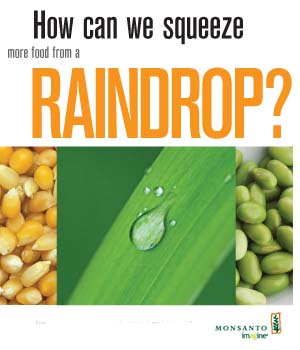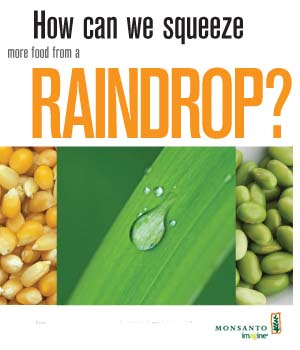Editor’s note: This post originally focused on NPR; but we’ve since found that the Monsanto ads run on Marketplace, produced by American Public Media, which isn’t directly affiliated with NPR. We regret the confusion.
—————-
 Monsanto’s ad blitzFor years my alarm has been set to public radio so I can lie in bed for five minutes and have a grasp on the day’s news before I even get up. I, like many other Americans, rely on NPR and other public-radio shows for news that is what I deem to be as unbiased and fair as possible. But this morning my ears burned as I listened to an on the American Public Media show Marketplace sponsored by Monsanto, the world’s largest corporate agribusiness chemical firm, touting how its genetically modified (GM) seeds are going to save the world from environmental catastrophe and human hunger. It left me wondering, particularly in tough economic times, how do media ethics hold up? (The GMO seed giant has been bombarding liberal-minded publications with similar propaganda, see image to the right, for months.)
Monsanto’s ad blitzFor years my alarm has been set to public radio so I can lie in bed for five minutes and have a grasp on the day’s news before I even get up. I, like many other Americans, rely on NPR and other public-radio shows for news that is what I deem to be as unbiased and fair as possible. But this morning my ears burned as I listened to an on the American Public Media show Marketplace sponsored by Monsanto, the world’s largest corporate agribusiness chemical firm, touting how its genetically modified (GM) seeds are going to save the world from environmental catastrophe and human hunger. It left me wondering, particularly in tough economic times, how do media ethics hold up? (The GMO seed giant has been bombarding liberal-minded publications with similar propaganda, see image to the right, for months.)
The Monsanto ads are quite simply false. The premise of the ad is more or less that Monsanto’s genetically modified (GM) seeds are going to save the world from environmental catastrophe and human hunger. All while the corporation made more than 11 billion dollars in 2008 amidst a world food crisis. The catch phrase, “Produce more, conserve more” even has its own website, which conveniently links directly to Monsanto’s website section on “sustainable agriculture”. But the reality of Monsanto’s seeds and the company’s ethics and commitment to fighting world hunger have nothing to do with producing more or conserving more.
Let’s get a few facts on the table. Eighty-five percent of all GM seeds are engineered for herbicide tolerance. Most of these crops are Monsanto’s “Roundup Ready” cotton, corn, soy, and canola seeds. What this tolerance means is that the plant can actually withstand significant amounts of pesticides being sprayed on it–in effect promoting pesticide use. In the past farmers were motivated to spray judiciously since their crops could be adversely affected. Farmers growing GM seeds don’t worry about this, and as a result there has been an increase in pesticide use in the United States since the introduction of GM seeds. The most comprehensive independent research done utilizing USDA data demonstrates that since the introduction of GM crops in the United States, more than 120 million pounds of additional pesticides were used. This seems to be a growing trend as well, as the active ingredient in Roundup Ready crops–glyphosate–s becoming less efficient and creating scores of resistant weeds, resulting in increased use.
In 2008 Monsanto’s total sales for Roundup and other glyphosate-based herbicides was more than $4 billion–up 59 percent from 2007. Perhaps more importantly, its gross profit from such sales was nearly 2 billion dollars- up 131% from 2007. So, what is Monsanto conserving more of? Certainly not biodiversity, human health, wildlife, pollinators or the soil, which are all adversely affected by pesticide use.
The claims of “producing more” that Monsanto touts in the NPR ads are also completely unfounded. Not a single GM crop has been commercially introduced that is intended to increase yield. Agronomists and plant scientists made far greater advances in yields through conventional breeding methods in the 20th century than they ever have with GM crops. In fact, there have been several studies which show that there are actually yield losses associated with Monsanto’s Roundup Ready soybeans. What biotech companies have been effective at doing is crafting media messages that persuade the average person to believe that their crops increase yield and that without GM crops we simply couldn’t feed the world.
In fact, GM crops account for less than 3% of total agricultural acreage globally. Five countries in North and South America account for more than 90% of total global acreage, with the United States, Argentina and Brazil making up 80% of total global GM crop acreage. In Africa, only two countries-South Africa and Burkina Faso-allow the commercial planting of GM crops, which are minimally grown. Less than 3% of the cropland in India and China is planted with GM crops, and in India most of that is cotton- not food. This leads me to my next point- four cash crops- soy, maize, cotton and canola make up almost 100% of GM crops planted worldwide. Of these commodity crops, most are used to make biofuels, processed foods, animal feed, and vegetable oils-they are not fed directly to people in their whole form. The bottom line? GM crops are not feeding the world, and they are not enabling us to produce more.
Perhaps the most important consideration for Monsanto’s ads on Marketplace is the unethical implications behind their words. They want us to believe their crops are feeding hungry children in Africa and that they are allowing farmers to use fewer chemicals. But their actions demonstrate that their concern lies otherwise- in their profits. In 2008, the International Assessment of Agricultural Knowledge, Science and Technology for Development (IAASTD) a global group of scientists, NGOs, private sector officials, and country governments initiated by the World Bank and the United Nations released its long awaited report, “Agriculture at a Crossroads”. The report painted a grim picture for food security and described the harsh reality of the challenges that agriculture and food systems must overcome to ensure food security in the future. What made the IAASTD report so groundbreaking was its unprecedented questioning of the role of GM crops to aid in food security and environmental improvement. IAASTD authors paraphrased the conclusions of the report in Science stating, “The assessment found GM crops appropriate in some contexts, unpromising in others, and unproven in many more. No conclusive evidence was found that GM crops have so far offered solutions to the broader socioeconomic dilemmas faced by developing countries.”
This was certainly not the golden ticket for GM crops that Monsanto hoped for from the IAASTD. So, what did they do? They bailed. The failure of biotech corporations to influence the IAASTD led Monsanto and Syngenta to withdraw from meetings and collaboration just a few months before the final release of their report. According to the journal Nature, which published a story on the issue titled “Deserting the Hungry?”, such actions resulted after drafts devoted more space to biotechnology’s risk than its benefits and failed to recognize that GM crops produced higher yields. In a year with unprecedented world hunger, Monsanto pulled out of the most comprehensive international attempts to examine the problems and solutions of the situation. And, they made 11 billion dollars the same year, mostly from their Roundup chemicals and biotech seeds-both which they increased in price at the height of a global food crisis. So, producing more and conserving more, or deserting the hungry?
I encourage American Public Media and all other news media services to think about their principles, ethics, and mission statements and consider applying these principles to the ads they are running.


